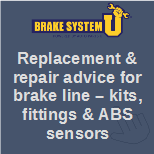The brakes help to slowdown the car. Most commonly, people think that the brakes squeeze against disc or drum, and that pressure slows down the vehicle. This is actually a part of the brake equation.
 The brakes are a mechanism to change the energy types. When you are traveling on your vehicle, it is kinetic energy, and if you apply the brakes, the vehicle will stop here the friction by the brake converting the kinetic energy into thermal energy. You need a method to apply the brakes in order to make them work. The method or mechanism starts from applying the force for brake through your foot or your hand, to force reaches the brake to stop, all of this process is the brake actuator system.
The brakes are a mechanism to change the energy types. When you are traveling on your vehicle, it is kinetic energy, and if you apply the brakes, the vehicle will stop here the friction by the brake converting the kinetic energy into thermal energy. You need a method to apply the brakes in order to make them work. The method or mechanism starts from applying the force for brake through your foot or your hand, to force reaches the brake to stop, all of this process is the brake actuator system.
- Cable operated: The cable-operated actuator is the basic one; at the each end of the lever, cable is connected. When you squeeze on one lever with your hand or press it with leg, it pulls the lever at the other end. An elliptical cam is placed at the brake end lever. In the brake shoe’s circular cup, the elliptical cam rotates inside, and forces the brake shoe to move apart.
- Solid bar connection: We can found the solid bar connection in older motorbikes rear brake. This system amplifies the force on the lever or pedal before it gets to the brakes. Along with the elliptical actuator solid bar connection system is used in the drum brakes. This system needs the suspension components matched pivot points or hinge, so it become a big disadvantage. If they are not present, when you are going over a bump, it put the brake as suspension moves relative to the lever.
- Single circuit hydraulic: The single circuit hydraulic brake actuator system is the most used system in motorbikes and cars today. The bars and cables are replaced with hydraulic fluid, reservoirs and plungers. This system has three basic components. Those are the reservoirs, the slave cylinder and the master cylinder. These are filled with non-compressible hydraulic brake fluid and joined together with hydraulic hose. A small piston assembly in the master cylinder is compressed when squeeze the brake lever or press with foot on the brake. The brake fluid does not compress, so instantaneously the pressure transferred to the slave cylinder through the hydraulic brake line. That the slave assembly is either connected the brake caliper or with the lever to activate the brakes, and the slave cylinder acts directly on the brake pads. The brake fluid absorbs the heat from the brakes because of arrangement of the slave cylinder.
- Dual circuit hydraulic: These are available in particular BMW bikes, newer motorbikes and on high luxury vehicles. It has two separate circuits, the command circuit and the separate circuit. The command circuit act with your foot or hand. The separate circuit is under the control of an on-board computer, and this is actually connected to the brakes. When you apply the brakes, the brake computer receives the pressure signals through the command circuit. The advantage with dual circuit system is, the command circuit system is separated totally from the brakes and never get the heat.
 Brake by wire: Brake by wire is the most advanced system until to date. These are the direct copy from some types of racing brakes. Dual circuit hydraulic system and the brake by wire are much similar, but in brake by wire system electronics are replaced to the command circuit of dual circuit hydraulic system. An electrical resistance measurement tool (hypersensitive rheostat) is connected with lever or brake pedal. Based on the operating of brake the brake computer gets the electrical signal. Means when you press more the electrical signal sent to the brake computer are more. From here onwards, it performs like the secondary circuit. The main advantage with this system is you can place the brake pedal or lever at anywhere.
Brake by wire: Brake by wire is the most advanced system until to date. These are the direct copy from some types of racing brakes. Dual circuit hydraulic system and the brake by wire are much similar, but in brake by wire system electronics are replaced to the command circuit of dual circuit hydraulic system. An electrical resistance measurement tool (hypersensitive rheostat) is connected with lever or brake pedal. Based on the operating of brake the brake computer gets the electrical signal. Means when you press more the electrical signal sent to the brake computer are more. From here onwards, it performs like the secondary circuit. The main advantage with this system is you can place the brake pedal or lever at anywhere.
Now check what type of brake systems your vehicles have. Based on different parameters of the vehicle the brake actuators are different. However, every brake system works well.
